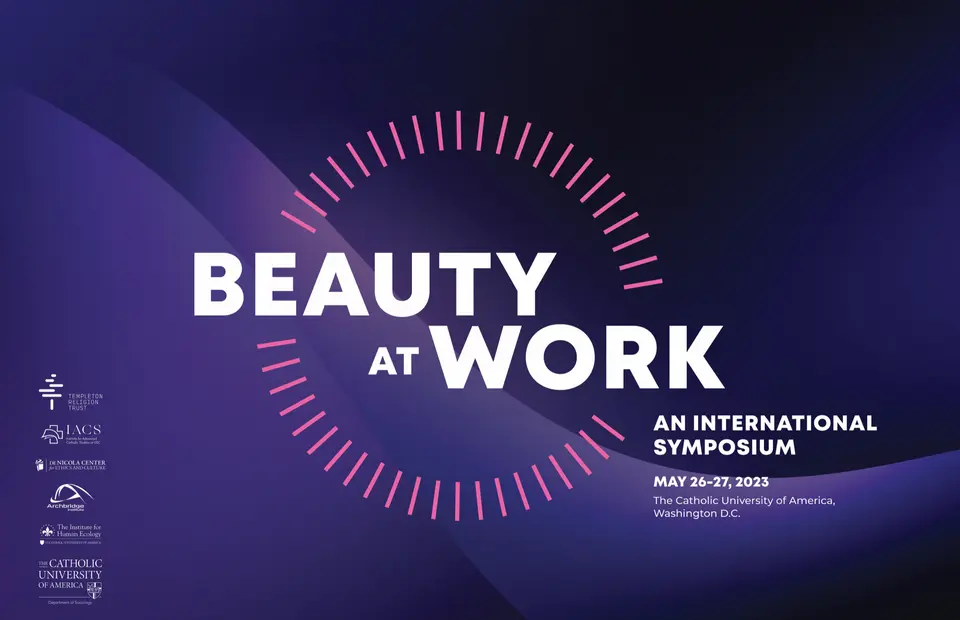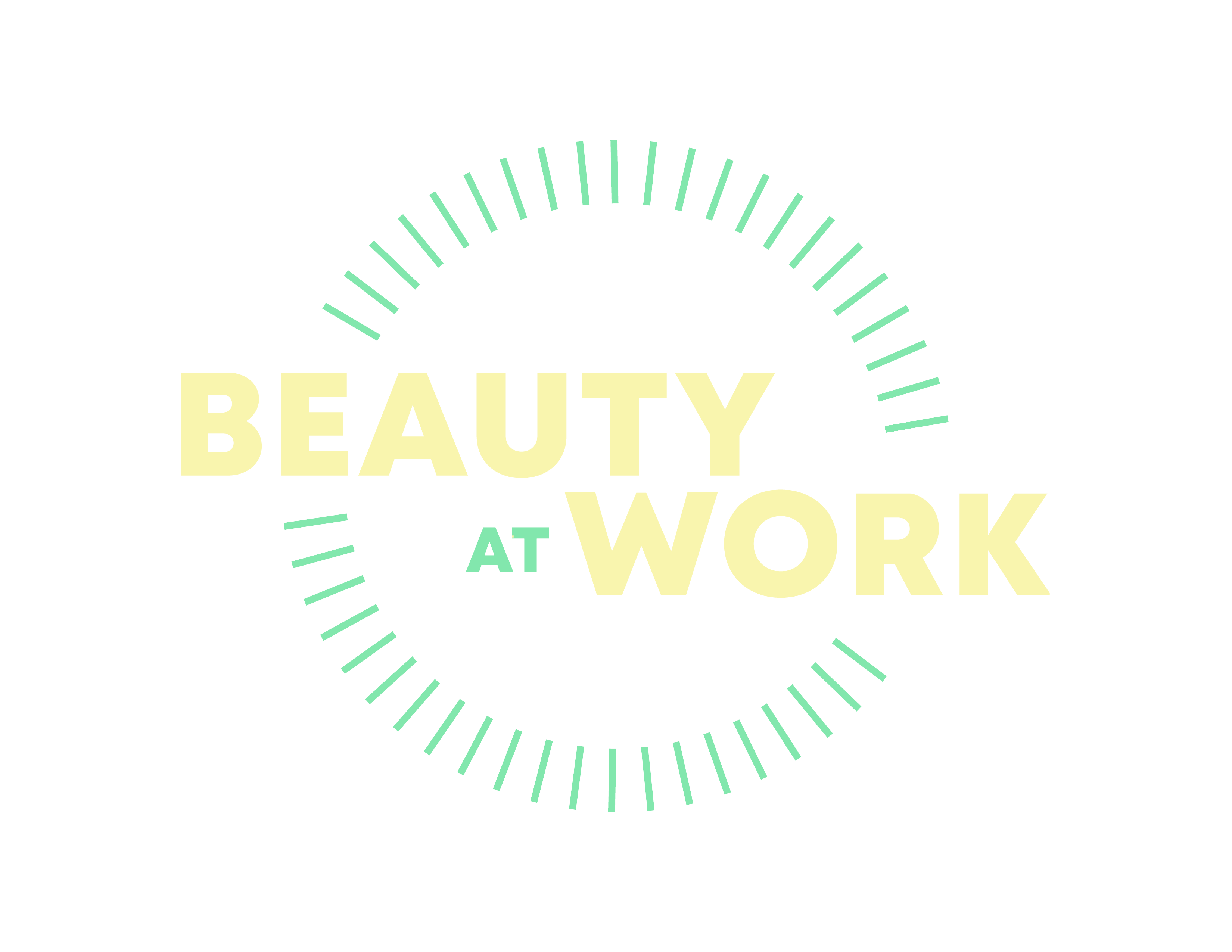International Symposium on Beauty at Work

On May 26-27, 2023, we held the first international symposium on Beauty at Work at The Catholic University of America in Washington DC.
The event built on the world's first large-scale study of the role of beauty in science to explore the role and relevance of beauty in other domains of work. Our research findings revealed that beauty matters immensely to scientists and shapes scientific work profoundly—though not always for the good. This left us curious to learn what beauty means to professionals in other fields, while also exploring how beauty works in our brains, our workplaces, our communities, and even our political lives.
I've been especially interested to see whether beauty might be a helpful sensitizing concept to guide fruitful inquiry, a generative lens to shed light on things that tend to go unseen and unacknowledged, and a catalyst to spark new connections and conversations across people who may not ordinarily come together. I'd love to know whether you think our event was able to do this to some extent – and if you weren't able to attend, you can watch the plenary sessions below.
Our event opened with a brief video summarizing the Work and Well-Being in Science study, followed by opening remarks by Dr. Peter Kilpatrick, President of The Catholic University of America. In his remarks, he discussed scholastic definitions of beauty and their relevance to his research as a scientist, remarking on the importance of beauty in both symmetry and asymmetry, perfection and imperfection.
Opening Remarks and Plenary Session 1 on Beauty in Science
Beauty in Science and Why it Matters. The first panel was a conversation between a biochemist (Dr. Robert Gilbert, University of Oxford), a particle physicist (Dr. Aaron Dominguez, Catholic University of America), and an astronomer (Dr. Massimo Robberto, Space Telescope Science Institute), moderated by Dr. Maria Teresa Landi (National Cancer Institute, NIH).
Dr. Gilbert discussed the relationship between form and suitability as well as subjectivity and objectivity in beauty. Dr. Dominguez commented on the importance of friendship among scientists that makes possible the discovery of beauty. And Dr. Robberto poetically observed that we as human beings are stellar dust capable of asking not only how things are made but why, and in doing so, we voice these questions for the stars, rocks, and protons which don't have a voice.
How Beauty Works. Day 2 opened with a discussion on how beauty works to shape our brains, the spaces we inhabit, and the communities we build. The panel, moderated by Christine Emba (Washington Post), included a neuroscientist (Dr. Anjan Chatterjee, University of Pennsylvania), a professor of sacred architecture (Dr. Julio Bermudez, The Catholic University of America), an award-winning designer (Pallavi Dean, Roar, Dubai, UAE), and a scholar of public aesthetics (Dr. Sheri Parks, University of Maryland).
Plenary Session 2: How Beauty Works
Dr. Chatterjee discussed the science of neuroaesthetics and the challenges posed by the intertwining of sensations and vauation in our brains. Dr. Bermudez discussed the power of sacred architecture across cultures to shape our attention and focus. Ms. Dean pointed to the tensions between form and function in the practice of design. Dr. Parks talked about the power of art as a meaning structure and its ability to transform relationships and communities.
What's Beautiful About Democracy? The closing plenary, moderated by Dr. Samuel Kimbriel (Aspen Institute) explored the connection of beauty to politics and justice, examining what if anything might be considered beautiful about democracy. Panelists included Dr. Hélène Landemore (Yale University), Osita Nwanevu (The New Republic), and Shadi Hamid (Brookings Institution). Our fourth panelist, Uma Viswanathan (The New Pluralists) unfortunately took ill and was unable to join us.
Dr. Landemore discussed how electoral democracy is characterized by ugliness, and proposed "open democracy" as an alternative, highlighting its potential for beauty in enabling us to come together as one people in a way that respects our plurality and diversity. Mr. Hamid discussed how dissonance and conflict could be beautiful. Mr. Nwanevu raised important challenges to perceiving democracy as beautiful and propsed that it may rather be a well from which beauty might spring. Overall the panel laid bare important tensions underlying the ideals and practice of democracy which need to be considered seriously in our times.
Panel 3: What's Beautiful About Democracy?
A series of concurrent panels throughout the day explored additional themes. Technological limitations made it impossible to record these conversations.
From Plotinus to Polanyi: Definitions of Beauty Across the Ages
Jack Boczar, Dominican House of Studies; Amrit Singh, Cornell University; Sally Mullis, University of Minnesota, Twin Cities; Moderated by Jeffrey Dirk Wilson, The Catholic University of America
Aesthetic Properties and Scientific Information
Myron Penner, Trinity Western University; Amanda Nichols, Oklahoma Christian University; Milena Ivanova, Fitzwilliam College Cambridge UK; Punya Mishra, Arizona State University; Rebecca Kamen, University of Pennsylvania; Moderated by Jonathan Buttaci, The Catholic University of America
Educating for Beauty and the Built Environment
Becky Cerling, Institute for Advanced Catholic Studies, USC; David Judson, Judson Studios; Christina Butler, American College of Buildings Arts; Alessandro Mele, Cometa Research, Italy; Moderated by Lee Cerling, University of Southern California
Beauty in Business
Anna Bond, Rifle Paper Co.; Jessica Rey, Rey Swimwear; Louis Kim, HP Inc.; Moderated by Beatriz Lopez Bonetti, The Catholic University of America
Beauty and Human Flourishing
Wayne Brezinka, Artist; Eri Mountbatten-O’Malley, Bath Spa University; Paul Radich, The Catholic University of America; Dony Mac Manus, Sculptor; Moderated by Dana Ray, Name Your Work
Convergences and Divergences in Art and Science
June Boyce-Tillman, University of Winchester UK; Timothy Reilly, Ave Maria University; David Corey, Baylor University; Wael Farouq, Università Cattolica del Sacro Cuore, Italy; Moderated by Bridget Ritz, University of Notre Dame.
I'm deeply grateful to the extraordinary team who put this event together and manage all its complexities and logistical challenges: Ginamarie Lynch, Angela Mayerle, Caitlin Fitzgerald, Bailey Haraburda, Marcela Duque Ramirez, Javier Mazariegos, Tess Rempel, Rui Barrios, and Anthony Apostolides. And my heartfelt thanks to the sponsors who made this event possible: Templeton Religion Trust, The Institute for Advanced Catholic Studies at the University of Southern California, the de Nicola Center for Ethics and Culture at the University of Notre Dame, Archbridge Institute, and the Institute for Human Ecology at The Catholic University of America.
If you're new to this site, please subscribe so you can stay updated on our future work. You may also be interested in our podcast (Season 2 launches on June 1st) to which you can subscribe on YouTube or wherever you get your podcasts: iOS | Android | Spotify | RSS | Amazon | Stitcher | Podvine

I'd love to know what you thought of the Symposium discussions. If you enjoyed these conversations, please share this page with your friends and colleagues.
Also please consider supporting this project as a paid subscriber to support the costs associated with this work. You'll receive early access to content and exclusive members-only posts.
